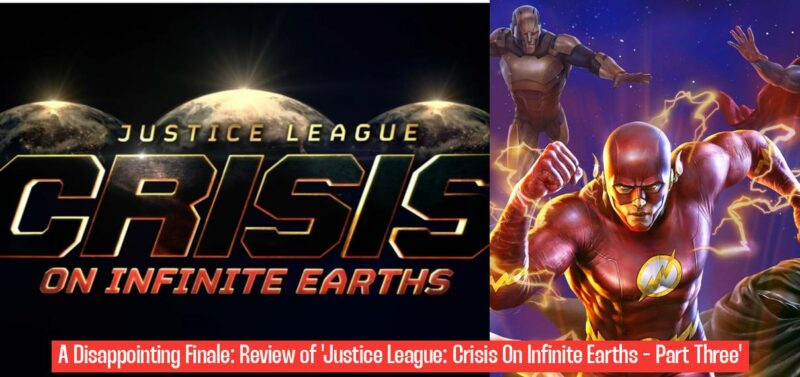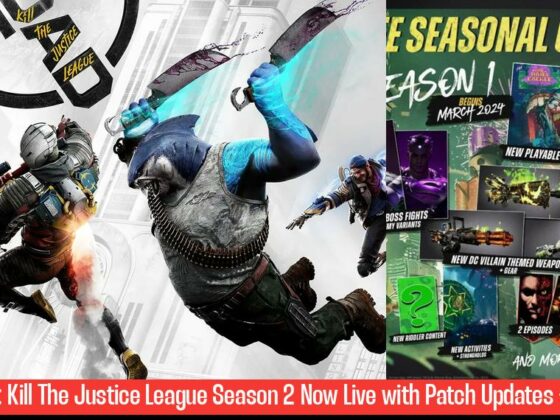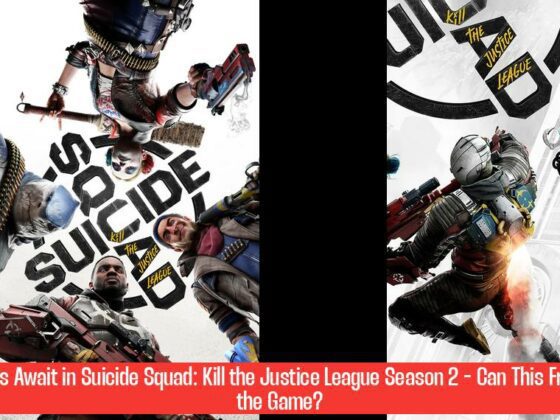‘Justice League: Crisis On Infinite Earths – Part Three’ Review
Features the voices of: Jensen Ackles, Troy Baker, Jonathan Adams, David Kaye, Meg Donnelly, Geoffrey Arend, Zach Callison, Gideon Adlon, Will Friedle, Stana Katic, Darren Criss, Ato Essandoh, Kevin Conroy, Mark Hamill| Written by James Krieg| Directed by Jeff Wamester
Justice League: Crisis On Infinite Earths – Part Three, picks up from the closing moments of Part Two with a distraught Supergirl (Meg Donnelly; Team Toon, The Winchesters) killing The Monitor (Jonathan Adams; Elemental, Reign of the Supermen), an act that somehow sends everyone into The Bleed, “an unstable dimension that exists outside The Multiverse, truly neither here nor there.”
That means it’s hidden from the Anti-Monitor (Ato Essandoh; Outpost, Millennium Crisis), and it’s also extremely unstable. How unstable you ask? Ten minutes into the film and what’s left of Earth – 1’s downtown Metropolis is being overrun with dinosaurs. It seems the various Earth’s pasts, presents and futures are in a constant state of collision. Nazis, armed with weapons confiscated from supervillains including Scarecrow’s fear toxin, show up in Earth – 2’s Gotham City.
While the hallucinations spawned by the toxin are effective looking, some of the dinosaur scenes are extremely cheap looking and, along with scenes of people being bitten but not bleeding, make what should have been an exciting opener fall flat. Worse, we’re told at length there aren’t enough resources for everyone, but we see Supergirl and Batgirl (Gideon Adlon; Batman: The Doom That Came to Gotham, Sick) eating doughnuts. Surely if everything needs to be tightly rationed, there are better uses for flour?
Eventually Batman, (Jensen Ackles; Supernatural, Batman: The Long Halloween, Part One) scours The Bleed for John Constantine (Matt Ryan; DC Showcase: Constantine – The House of Mystery, Constantine) whose powers seem to be the only thing effective against The Anti-Monitor, they just have to figure out which Earth he’s passed out drunk on. They don’t however have to find The Anti-Monitor, because he has somehow managed to find a way into The Bleed.
All of this should be exciting, but Justice League: Crisis On Infinite Earths – Part Three never really manages to take off. Director Jeff Wamester ( Justice League: Warworld, Green Lantern: Beware My Power) and writer James Krieg ( Batman: Gotham by Gaslight, Scooby-Doo! Frankencreepy) certainly have great source material to work with.
They also have a cast that includes a final performance by the late Kevin Conroy (Justice League vs the Fatal Five, Batman: Assault on Arkham) as Earth-12 Batman and, fittingly, Mark Hamill (Batman: Killing Joke, Star Wars) as Earth-12 Joker, reputedly the last time he’ll voice The Joker. That’s on top of those I’ve already mentioned and, among others, Alexandra Daddario (Texas Chainsaw, Mayfair Witches) as Lois Lane, Katee Sackhoff (The Mandalorian, Night of the Animated Dead) as Poison Ivy, and Lou Diamond Phillips (Young Guns, The 33) as The Spectre.
Despite all that, there’s never any real sense of suspense or danger. Superbeings fight, planets explode and space is literally ripped open, but it has little impact. Even worse are attempts at emotional scenes like Aquaman (Liam McIntyre; Bring Him to Me, Suicide Squad: Hell to Pay) rushing home to die with his family. Rather than evoking pathos, it’s just sappy and pathetic.
A large part of the problem, as it was with the previous chapter, is the attempt to fit in such a huge cast of characters, even The Losers get a cameo this time around. Rather than concentrate on the most compelling characters and events from the original comics, the script keeps interrupting them for a quick appearance by yet another character who isn’t particularly important to the overall story. If Warner Bros. really wanted to cover so much ground, they should have done this as a limited series for cable and given it all proper coverage.
But they didn’t, and between the lacklustre storytelling and uneven animation, Justice League: Crisis On Infinite Earths – Part Three brings a disappointing adaptation of a landmark storyline to an end, not with a bang, but a whimper.
2/5
Justice League: Crisis on Infinite Earths – Part Three is available as a 4K/Blu-ray Streelbook, as well as on VOD and Digital Platforms from Warner Bros.
A Disappointing Conclusion to a Promising Story
Trending — Benedict Cumberbatch’s Involvement in Avengers 5: What We Know So Far
The third part of the “Justice League: Crisis On Infinite Earths” animated film series is a major disappointment, failing to live up to the potential of its predecessor. Despite boasting a star-studded voice cast and impressive source material, the film falls short in terms of storytelling, pacing, and emotional impact.
One of the most significant shortcomings of the film is its pacing. The story feels rushed and disjointed, jumping between different characters and storylines without giving them adequate time to develop. This results in a fragmented narrative that leaves viewers feeling lost and confused. The constant switching between different Earths and time periods also creates a sense of disorientation, making it difficult to follow the plot.
Lackluster Storytelling and Uneven Animation
The film also suffers from a lackluster storytelling approach. While the original comics presented a complex and compelling narrative, the film falls short of capturing the emotional weight and dramatic stakes of the source material. The dialogue is often clunky and predictable, failing to evoke the sense of urgency and danger that should permeate a story of such magnitude.
The film’s animation is also uneven. While some scenes are visually impressive, others are surprisingly cheap-looking, especially the dinosaur scenes, which appear to be straight out of a low-budget sci-fi movie. The animation style itself feels inconsistent, lacking the polish and fluidity that we’ve come to expect from DC animated films.
A Disconnected Emotional Experience
The film also fails to connect with audiences on an emotional level. The attempts at emotional scenes, such as Aquaman’s farewell to his family, fall flat, coming across as sappy and contrived. The film’s overall tone is strangely detached, lacking the emotional resonance and gravitas that such a momentous event should possess.
A Missed Opportunity for a Compelling Story
“Justice League: Crisis On Infinite Earths – Part Three” is a missed opportunity. The film had the potential to be a captivating and emotional conclusion to the Crisis storyline, but instead, it delivers a lackluster and disappointing finale that fails to live up to the legacy of its source material. The film’s pacing issues, uneven animation, and disconnected emotional experience make it a difficult experience for fans of the original comics and newcomers alike.
A Missed Opportunity to Honor the Legacy of the Crisis
The “Justice League: Crisis On Infinite Earths” animated film series was a promising project that unfortunately failed to reach its full potential. The third installment, in particular, suffers from a series of shortcomings that ultimately undermine the story’s impact and emotional depth.
The film’s pacing is a major issue, with the story constantly shifting between characters and storylines without giving them enough time to develop. This creates a fragmented narrative that is difficult to follow and leaves the audience feeling disengaged. The constant switching between different Earths and time periods also adds to the sense of disorientation, making it hard to track the plot and appreciate the significance of the events unfolding on screen.
A Disconnected Emotional Connection
The film’s emotional impact is also severely lacking. The attempts at emotional scenes feel forced and contrived, lacking the genuine pathos and emotional resonance that the original comics so effectively conveyed. The overall tone of the film is strangely detached, failing to convey the sense of urgency and desperation that should permeate a story of this magnitude.
A Disappointing Adaptation
The film’s adaptation of the Crisis storyline is also problematic. While the original comics presented a complex and nuanced narrative, the film simplifies the story and glosses over many of the intricate details that made the original so compelling. The film’s focus on a vast cast of characters also works against it, preventing the filmmakers from delving deeper into the individual stories and relationships that would have made the film more engaging and emotionally resonant.
The Need for a More Focused and In-Depth Storytelling Approach
The “Justice League: Crisis On Infinite Earths” animated film series had the potential to be a truly memorable and impactful adaptation of a landmark comic book storyline. However, the series ultimately falls short of its potential due to its rushed pacing, uneven animation, and lack of emotional depth. The filmmakers missed an opportunity to create a truly engaging and compelling adaptation of a classic story, opting instead for a superficial and rushed treatment that fails to capture the spirit and essence of the original source material.
Conclusion
While “Justice League: Crisis On Infinite Earths – Part Three” boasts a star-studded cast and impressive source material, it falls short of capturing the spirit and emotional depth of the original comics. The film’s pacing issues, uneven animation, and lack of emotional impact make it a disappointing conclusion to a promising story.
The filmmakers missed an opportunity to create a truly engaging and compelling adaptation of a classic story, opting instead for a superficial and rushed treatment that fails to capture the spirit and essence of the original source material. Ultimately, the film is a missed opportunity to honor the legacy of the Crisis storyline, leaving fans disappointed and wishing for a more faithful and impactful adaptation of a beloved comic book event.
What are some of the key voice actors featured in ‘Justice League: Crisis On Infinite Earths – Part Three’?
The voices in the movie include Jensen Ackles, Troy Baker, Jonathan Adams, David Kaye, Meg Donnelly, Geoffrey Arend, Zach Callison, Gideon Adlon, Will Friedle, Stana Katic, Darren Criss, Ato Essandoh, Kevin Conroy, and Mark Hamill.
What is The Bleed in ‘Justice League: Crisis On Infinite Earths – Part Three’?
The Bleed is an unstable dimension outside The Multiverse, hidden from the Anti-Monitor, and is described as neither here nor there.
What challenges do the characters face in ‘Justice League: Crisis On Infinite Earths – Part Three’?
The characters encounter Earths colliding, dinosaurs overrunning cities, Nazis armed with supervillain weapons, and scarcity of resources leading to conflicts over rationing.
Who are the director and writer of ‘Justice League: Crisis On Infinite Earths – Part Three’?
The movie is directed by Jeff Wamester and written by James Krieg.



